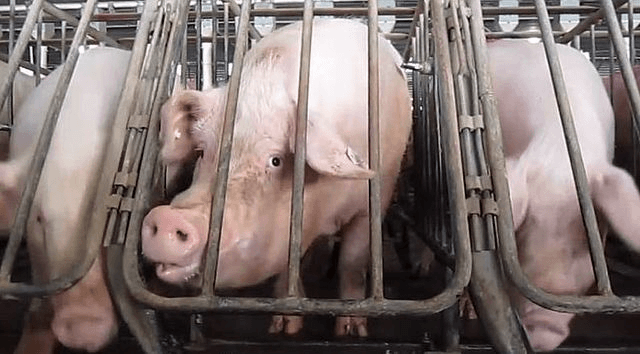Livestock farming generates some striking external impacts: while production provides 30% of human dietary protein, it occupies 75% of agricultural land, emits 14–17% of anthropogenic greenhouse gas emissions, and uses more antimicrobials than the whole of human medicine.
Demand for livestock products is high and rising, especially for pork which has increased fourfold in the past 50 years. How we meet this rising demand will be pivotal for health and the environment.
And yet our current understanding of different farming systems, and how their cumulative external impacts compare, is relatively limited. Research typically focuses on impacts in isolation, and the synergies or trade-offs between them are extrapolated or assumed.
Our peer-reviewed study, recently published in the Nature journal Scientific Reports, set out to test a common assumption: while higher-yielding, more intensive systems of livestock farming produce more food on less land, they may also involve higher antibiotic use, and therefore pose increased risks to human health through driving antimicrobial resistance.
This assumption is frequently reinforced in the campaigning messages of businesses and organizations opposed to more intensive farming systems. The Soil Association, for example, asserts on its website that:
It is intensive farming systems that use drugs at unnecessarily high levels, putting human health at risk.
As described below, the results of our study found only weak evidence to support this claim – and importantly we found several farms which combined high yields AND low antibiotic use. Such production systems may provide a guide to meeting a predicted doubling of demand for meat protein by 2050 in the most sustainable way.
The study
Two important externality costs of livestock production are land use and antimicrobial resistance (AMR).
Extensive field studies have consistently found that farming would have least impact on biodiversity if demand for food was met by coupling high-yield production systems with sparing remaining land for nature. Our study therefore used land-use cost as a proxy for negative impact on biodiversity, with low land-use costs (high yields) representing lower impacts on biodiversity compared with a natural habitat baseline. There is also substantial evidence that systems with low land use also often have smaller greenhouse gas footprints.
However, high-yielding, more intensive livestock farming is also perceived to impose other negative costs including increased use of antibiotics which drives antimicrobial resistance (AMR). Using antibiotic use as a proxy for risk of AMR, therefore, our study sought to quantify the externalities of both land use and AMR, and how they co-vary for a broad range of production systems in the UK.
Our analysis focused on pig production as there is a pressing need to identify and promote systems that combine low externality costs. Demand for pork is increasingly rapidly, pigs are the highest livestock users of antimicrobials globally, and pork production uses around 120 million hectares of land globally, including some 8.5% of global arable land.

We studied 74 UK pig farms comprising: 4 systems with no label type, 31 Red tractor, 12 RSPCA assured, 18 free range, 3 woodland and 6 Organic systems. Of these 74 systems, 31 were indoor-bred, 2 were hybrid indoor/outdoor systems and 41 were outdoor-bred.
Land-use costs varied both within and between labelling categories and ranged massively (up to 12-fold) from 3 to 36m2 per kg deadweight. Organic production systems had significantly greater land-use costs than RSPCA-assured, Red Tractor and “no label”.
Antimicrobial use (AMU) costs on the farms studied also ranged widely from 0 to 301 mg/kg deadweight, but we found only weak evidence of negative correlations between AMU costs and land-use costs.
The best performing 50% of farms for both costs included systems from different label and husbandry types. The 11 breed-to-finish systems in the lowest 50% for both land-use and AMU costs comprised eight Red Tractor systems (including three that were also RSPCA assured), in addition to two “no label” and one woodland system, which was also free range. None of the six Organic systems fell in this best-performing set of farms.
When classified by husbandry type, five of the 11 best performing systems in terms of land use and antibiotic use were indoor-bred, four were outdoor-bred, and two were hybrid indoor-outdoor bred.
The results of this study, by far the largest of its kind, and the only study to compare so many different label and husbandry types, serve to challenge the widespread perception that “intensive” livestock production systems, which are relatively higher-yielding (and so have lower land-use costs), always and inevitably have trade-offs in the form of higher antimicrobial use. We found weak evidence that overall higher-yielding systems have higher antibiotic use, indeed several of the farms studied combined high yields and low antibiotic use – showing it is possible to farm pigs with relatively low land- and antibiotic-use.
Concluding remarks
Producing enough food for a growing world population, while tackling the climate crisis and better protecting biodiversity and natural ecosystems, is arguably the greatest challenge facing humankind this century.
With finite natural resources of land, water and energy, this study highlights the importance of using scientific data and evidence to understand and drive best practice in sustainable agriculture.
It also underlines the urgent need to establish a coherent and consistent system of evidence-based sustainability metrics to evaluate and compare the external impacts of different farming systems per unit of food produced, to ensure future agricultural policies are based on empirical data, not on unfounded claims or popular assumptions.
Dr. Harriet Bartlett is a researcher at the University of Oxford, but carried out this work while at the Departments of Zoology and Veterinary Medicine at the University of Cambridge. She is lead author ‘Identifying ways of producing pigs more sustainably: tradeoffs and co-benefits in land and antimicrobial use’ is available to download here. Find Harriet on Twitter @HarrietBartlett
A version of this article was originally posted at Science for Sustainable Agriculture and is reposted here with permission. Any reposting should credit the original author and provide links to both the GLP and the original article. Find SSA on Twitter @SciSustAg

